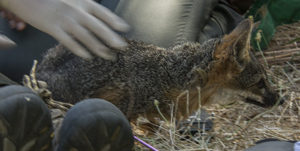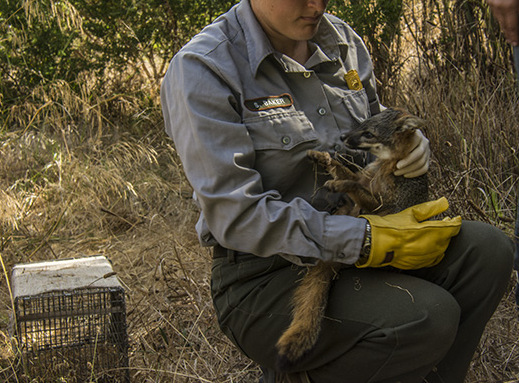Channel Island foxes are no longer endangered. Photos by Richard Lieberman
(for more photos visit www.venturabreeze.com)
by Sheli Ellsworth
On a pristine Southern California morning, August 11, blue skies and calm waters welcomed dozens of invited guests to the Channel Islands National Park to celebrate.
Joining the press conference were members of the National Park Service, Fish and Wildlife Service and the Nature Conservatory and the media. What was the big event? An endangered species, once numbering as low as 70, is now back in full force. The Channel Island fox population was officially removed from the endangered species list and in record time.
 The Channel Island foxes are the only carnivore unique to California. Their decline was chronicled in the 2011 T. C. Boyle novel, When the Killing’s Done. First the black rats came, then the non-native feral pigs and finally the golden eagles that preyed on the baby pigs and the foxes. The subspecies of fox on Santa Catalina, decimated by an outbreak of canine distemper, remains threatened.
The Channel Island foxes are the only carnivore unique to California. Their decline was chronicled in the 2011 T. C. Boyle novel, When the Killing’s Done. First the black rats came, then the non-native feral pigs and finally the golden eagles that preyed on the baby pigs and the foxes. The subspecies of fox on Santa Catalina, decimated by an outbreak of canine distemper, remains threatened.
Removing the invasive species became a controversial issue. In 2001 and 2002, the National Park Service poisoned Anacapa Island’s non-native black rats. In March of 2004, four of the Channel Islands’ subspecies were placed on the federal endangered species list. Then the park service and other government agencies collaborated with the Nature Conservancy to eradicate (shoot) the feral pigs, relocate the golden eagles and reintroduce the native bald eagles wiped-out by the use of DDT. The agencies spent $20 million donated by public and private sources on the environmental project. Through captive breeding and rearing, native foxes number in the thousands as of 2015. There are 700 on San Miguel; 1,200 on Santa Rosa and 2,100 on Santa Cruz.
A National Park Service boat ferried the group to Prisoner’s Harbor on Santa Cruz Island to observe the routine health checks that insure the population’s survival and to hear welcoming speeches. Collar monitoring for some foxes and vaccines for canine distemper will continue.
Smaller than a housecat, the reddish foxes that eat certain plants, deer mice, crickets, grasshoppers and ground nesting birds may be descendants of the gray fox that was brought to the islands by man about 6,000 years ago. The 4-5 pound foxes inhabit six of the eight Channel Islands and live up to 15 years. They mate in the spring and usually have litters that number from 1-5.
The three species of Channel Island fox are in a list of 37 species removed from the endangered species list since the Endangered Species Act passed in 1973. California currently has 119 animals on the endangered species list according to the U.S. Fish and Wildlife Service’s website.

